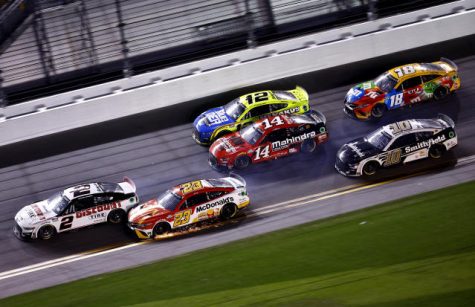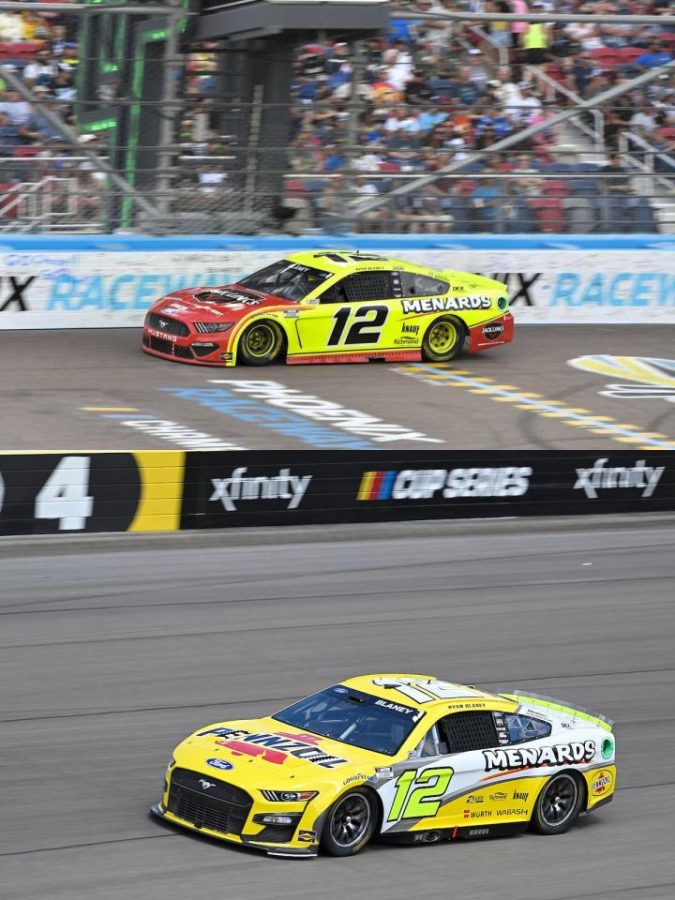NASCAR rolls out contentious ‘Next-Gen’ cars
Top photo, Ryan Blaney’s Gen-6 2021 car. Bottom photo is his Next-Gen car. There are noticeable differences between body shape and the different wheels (Both photos courtesy of Team Penske’s multimedia gallery).
March 23, 2022
40 shiny new NASCAR cars come thundering by, two by two, through turn four at the Daytona International Speedway. The newest season of the NASCAR Cup Series is starting, and millions of people are tuning in to watch. Except this year, the Daytona 500, one of the most well known American races, will include some major changes. NASCAR (National Association for Stock Car Auto Racing) rolled out the seventh-generation Cup car, known as the Next-Gen.
With testing for the Next-Gen cars stretching into January, there was unease over whether or not the cars would be ready for the Daytona 500 on Feb. 20. Drivers were busy testing over the regular three-month offseason, and it hardly felt like a break. Normally testing is not as intensive, focusing on improvements to an already existing car model. However this year as the season drew closer, they were still testing different racing packages, having trouble balancing horsepower and downforce. There was a battle between the cheaper 550hp-high downforce cars that NASCAR was pushing and 750hp-low downforce cars fans wanted to see. Fans and drivers alike expressed displeasure with the quality of racing produced by the low horsepower car. Initial testing data and driver opinion deemed this configuration undrivable. The cars were too loose when driving alone, and difficult with high levels of turbulence from the dirty air when racing together in packs. In somewhat of a compromise, it was agreed upon that the new racing package would be 670hp, with different configurations for a few select tracks and superspeedways. One thing NASCAR was trying to emphasize with their setup was to make sure that further into races there would still be an opportunity for passing and on track action, instead of cars creating and maintaining gaps. They also wanted to maintain the emphasis on pack racing at superspeedways like Daytona.
This entailed a complete overhaul of the old car. These changes brought the car back towards the “stock” in NASCAR with the new car looking more like the model commercially available for purchase. Teams were no longer creating their parts in their shops, and instead the series would be sourcing them from single vendors. In an interview with USA Today, Brandon Thomas, NASCAR’s managing director for vehicle systems, said the goal was to “reset everything from a competitive landscape.”
This goal was lofty and not everyone agreed with it. “The quote of a ‘level playing field’ is grossly probably overused,” said driver Denny Hamlin in a press conference. Tyler Reddick, agreed saying, “In some cases, it’s going to have the opposite effect.” Across all racing there is the correlation between teams with more money, facilities, and experience and a higher level of success. NASCAR was aiming to remove this issue and make it a competition of driver ability rather than a team’s technical and mechanical skill. This is similar to the goals of its American racing counterpart, IndyCar. The benefit to racing a spec car means the championship will come down to how well a driver can handle the car and perform well consistently.
The arguably biggest change would be that the new car body would be made out of carbon fiber -replacing its sheet metal predecessor- to create a stronger, but lighter outer body. NASCAR is the last of the three major racing series across the world to adopt a carbon fiber body. IndyCar and Formula 1 have been using it much prior to this, albeit with completely different open-wheeled cars. The carbon fiber composite is superior because it is able to withstand the heat produced by the cars.
NASCAR also adopted 18-inch aluminum wheels instead of the 15-inch steel ones. Each wheel has one larger lug nut replacing the traditional five. It is necessary to note that these changes only apply to the uppermost NASCAR Cup Series. The Xfinity series, the stock series a tier behind Cup (functioning somewhat as a feeder series or proving ground for drivers) did not roll out a drastically different 2022 car. Although, they had already phased in carbon fiber body panels. Not all changes to the Cup car were aesthetic though.
No longer will the cars have a four-speed H-pattern gearbox. The Next-Gen car features a five-speed sequential transmission. Within this, there is the ability to add in a hybrid system in the future, according to PMW Magazine.
Before the official season started, NASCAR held an exhibition race inside the Los Angeles Memorial Coliseum. This would be the first competition with the Next-Gen cars. Despite it not being for points in the 2022 championship, teams still came to fight and win. Throughout the qualifying heats and races, the cars inevitably made contact, but the outcome was mainly scuffing and scraping on the car wraps.
The temporary quarter-mile track would be built on top of the existing turf inside the Coliseum. It was more of a spectacle than a racing event, but without a doubt drew fans into the sport who would have otherwise not seen it. Pitbull performed a 45-minute concert prior to the race. It may seem like an interesting choice of performer at a NASCAR race based on the fanbase who often love country music, but he is a team partner to the Trackhouse Racing Team. The Clash was a commercial success, according to Fox, luring in 4.8 million viewers — for reference, in 2020 the event brought in 2.6 million. In previous car generations, even slight contact could end someone’s race day. These new cars could spin into the wall and still be drivable (granted the top speeds were not too high, due to the track length and size). This was promising for the new car, even if not running at full speed.
The Daytona 500 was run successfully, although there were cars that did not finish due to wrecks. Harrison Burton’s car went airborne, rolled upside down, and then righted itself. Burton was uninjured, and the car was not as damaged as expected, although his race was over. The pack racing was successful with 35 lead changes between 13 drivers. The race was run like any other year of Daytona, and the fears were quieted. Cars could bump each other while drafting without necessarily wrecking (although Brad Keselowski did end a few teams days, showing a newfound aggression in the Next-Gen car). After a late yellow, Cup series rookie Austin Cindric won the race with the leaders fanning out to take the checkered flag.

In recent races at tracks like Phoenix and Las Vegas there have been wrecks, but crews are having less difficulty repairing the cars. We are seeing less cars getting sent to the garage with race-ending damage. Although, an ongoing issue is the changes with the single lug nut wheels. The lug nut has been falling out of the gun (where it should stay after getting taken off) and tire changers must pull the extra one they all carry on their body, load it into the gun, and then put the tire on. This has caused those pit stops to take longer. Also, crews are still adjusting to tightening the new, large lug nut because there have been multiple instances of a tire coming off while on track.
The Next-Gen car has brought in a new era for NASCAR. With these changes to the regulations, drivers and teams alike have had to adjust to remain competitive. Although there was unease with the new car before it was used in a points-race, it has proven since the Daytona 500 that it is just as reliable and competitive as the older cars have been. With the rules still getting updated as the 2022 season goes on, it will be interesting to see how each team will adapt — and begin testing the limits of both the car and the rulebook.
